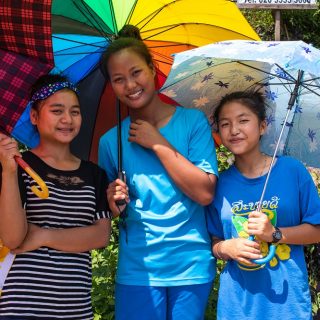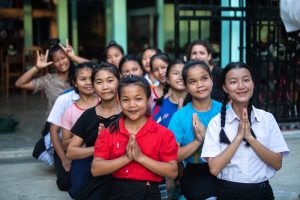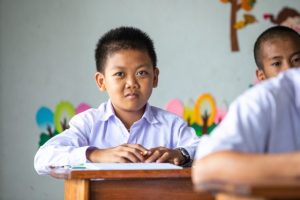Laos – Deaf children weave their way to a better future in Luang Prabang
FINDING A PLACE IN LAOTIAN SOCIETY DESPITE THEIR HANDICAP
« Tap, tap, tap! » The sound of bags of mushroom soil, filled and piled onto the floor by a merry band of teenage girls, echoes rhythmically in the barn. We are in Luang Prabang, the former royal capital city of Laos, a country landlocked between Thailand, Myanmar, China, Vietnam and Cambodia. It is 6 p.m. in the nuns’ foster home where these fifteen young girls are staying. The air is barely beginning to cool; the rainy season – with extremely high temperatures – is already well established. Sitting in a circle around a large heap of brown earth mixed with rice and sugar, the young girls giggle and laugh and are not afraid to throw a few handfuls of the mix at each other. They surreptitiously glance at the TV in the foster home, which broadcasts their favourite soap opera just a few metres away. The bags of soil will soon be “fertilized” and then carried into a dark, damp room where the mushrooms can grow before being sold. Despite the cheerful mood, no words are exchanged. Most of these young girls are deaf and mute. They communicate through Lao sign language, which they learned in the Luang Prabang Deaf and Mute School, a fifteen-minute bike ride away. Founded by the Sisters of Charity in 2006, it is one of the only three deaf and mute schools in this communist country, where deafness places a real burden on poor families and deprives children of schooling. About sixty pupils, from age 8 onwards, are accommodated in this school and continue their education up to the equivalent of the third class of the middle school. From age 13, the girls live with the Sisters in a foster home and split their time between school, vocational training and the management of a small farm, which allows them to provide for their food almost independently. In a few years time, these young deaf-mute people undergo an incredible psychological and intellectual transformation, which enables them to find their place in Laotian society despite their handicap.


“When I was little, I worked in the rice field with my brother, Kalong, who is also deaf” explains Noy, a 17-year-old girl with a gentle smile, who was born in a village in the far north of the country where animist beliefs are held. “The working conditions were harsh for children” she continues. “We were isolated because of our disability, especially since the schools could not accommodate us. Fortunately, me and my brother, I supported each other and communicated by scribbling on paper” says Noy.
NOY: FROM RICE FIELDS TO LEARNING TO WEAVE
Placing her bag of soil on the ground for a few moments, the young girl confides in her plans for the future. In Laos, it is not uncommon to come across families with several members with a disability. These are often caused by toxic components of ammunition and remnants of explosives that were dumped on the country during the Vietnam War. For nine years from 1964 onwards, a bomb was dropped on Laos every eight minutes… 30% of these bombs have been buried in the ground and to date have still not exploded, which explains the land and water contamination in some areas, in addition to the many accidents.
In the barn, a few dogs taken in by the Sisters stand guard around Noy. Outside, the sun is shining its last rays on the vegetable garden, which separates the girls ‘dormitory from the nuns’ accommodation. In the distance, we can hear the squeals of the little piglets that the sow has just given birth to. “When I finish school, I will go back to my village to weave,” the young girl continues. My mother was a seamstress too. When I was 14, she died from a stomach problem that could not be taken care of because of a lack of money,” she signs, moving her hands with confidence. “At the foster home, we enjoy the benefits of a well-balanced living environment. We have good teachers educating us. I can easily get started once I get home and start a family, ”she says before conscientiously resuming her activity. Between farm work from 5 a.m. to 6:30 a.m., school until 4 p.m., more work until dinner and study in the evening, the days do not leave much room for leisure activities for these teenage girls, who – like all young people of their age – are connected to the world through social media. But they are no less aware of how lucky they are. “I have to finish my studies, it’s essential,” Noy concludes.
In Laos, weaving is a safe profession. There will always be demand for fabric: shirts, scarves, tablecloths, bags, baby carriers, “sinhs” – those traditional silk or cotton skirts worn by women in daily life. At the foster home, the girls make beautiful pieces that they sell to visitors, donors and friends passing by. During this weeklong break, they often get down to work. Facing large wooden frames, the little brown heads patiently intersect the longitudinal threads with the transverse threads, while slowly and steadily pressing down on a pedal as if they were playing the piano. They also learn to weave bamboo baskets, cook and use the computer together with the boys who are trained in mechanics as well. “Learning a profession promotes social integration and resilience, and offers a way to lift one’s family out of poverty all at the same time,” says Marianne, a volunteer-computer teacher. “It goes hand in hand with education. In order to run a business, it is important to know how to read and keep proper accounts, to have an excellent working knowledge of English… “
SOMSOUK : GETTING READY FOR THE OUTSIDE WORLD

At school and in the children’s home, everyone has dreams for their future, like young Somsouk for example, who came back thrilled with her 3 weeks of civil service in the army. “I’d love to go back into military service for another 2 years before becoming a teacher,” exclaims this hopeful young girl of Khmu descent, one of over 80 ethnic minorities in this country of almost 5 million habitants. “I loved learning to fight and to stand up for people.” The fourth child in a family of eight, fatherless with a disabled mother, Somsouk was taken in by nuns because of her particularly difficult situation. She says she takes strength in the example of deaf girls who fight to succeed despite their disability.
‘We teach them to tackle life head-on, to find work on the outside world’ explains Sister Sonvongsouk on one of the school premises a few kilometres away. She is in her fifties and manages the project. With a jovial smile, round cheeks and perceptive gaze, the well-tempered nun masterfully directs everything. She is full of ideas to raise funds, including for example the new opening of a garage and a café at the children’s home. For the last 11 years, she has seen generations of suffering students step through their school gate in Luang Prabang and leave with their heads held high. On this particular summer’s day, the sun is reflecting off the large buildings onto the red-tiled roof of the school, empty of children. The nun proudly surveys the rows of bamboo, mango and Royal Poinciana trees with their red flowers which are used in bouquets for Lao New Year in April. “We have started building a school thanks to the financial support from the Vatican, who previously provided us with two other buildings in 2008 (when the young girls home were established) and in 2015,” she explains. Today the nuns benefit from donations from wealthy Laotians and foreigners but also through sponsorships funded by the charity ‘Children of The Mekong’. The charity sends money each month for the young girls in the children’s home to attend school and has also set up collective sponsorship programmes within the school. “Children arrive at the school-aged 8-12, sometimes later in the case of families in extreme poverty who keep their children to help work in the fields or forests,” the nun explains. In this country, inhabited by a majority of Buddhists and some Animists ethnicities, deaf children are often excluded as a result of their disability. “People say disabilities are a result of a child’s sin or their parent’s sin,” explains the headmistress. In truth, there are others that believe religion is often an excuse for ancestral fears and superstitions.
SOM : FROM FINDING HIS VOICE TO FRIENDSHIP

“I was disappointed when I found out my son was deaf,” Chamsouk, Som’s mother confesses at a dinner table laden with chicken, grilled fish, mushroom, rice and mangoes. The comfortable family home of the meat sellers is found at the end of a little alleyway in the centre of Luang Prabang. “It was the antimalarial treatment I was given while I was pregnant that caused his disability,” she explains. “When Som started school, aged 10, I was relieved. Before, he was often left to his own devices, so he used to wander off. Sometimes, I just didn’t know where he was. It was dangerous. Nowadays, he is conscious of the time, he does his homework and has become sensible. This school has given him both joy and plenty of friendships.”
‘Friendship’ is the first word that the children sign when they are asked about school. “When they arrive at the centre, the children don’t know how to communicate. Sometimes, they haven’t learnt to eat at fixed mealtimes or the basics of personal hygiene. They almost behave like animals,” Sister Sinvongsouk tells us. School provides them with love from friends who understand them and language, a sudden ray of light that opens up the outside world to them. A key step in all types of learning.
“Certain children make exceptional progress” Manon, a young volunteer, opens up to us in front of the empty school buildings. The 22-year-old musician has been teaching English there for a year. “I look after Bec, an 8-year-old boy who stopped speaking when his parents died in a motorcycle accident in 2017. To begin with, he cried a lot and lost his temper. We worked a lot together through art therapy. After a while, he began to talk again, and he told me about the accident. At the end of the year, he was no longer losing his temper.”
AENG: RESILIENCE AND GRATITUDE
Aeng has also shown remarkable resilience, a 24-year-old teacher who is hard of hearing and was taken in by the school in 2008. “When I was younger, my family made no effort to communicate with me. They didn’t even try to write; they merely mimed the bare minimum of what they needed to. I worked with my parents in the paddy fields. One day my mum heard them talking about the school on the radio. As soon as I arrived at the school everything became a lot easier: making myself understood, making friends…” After getting his GCSE’s, Aeng started a 2-year teacher training course, before finishing by perfecting his sign language in Thailand. Today he wants to give back to the students what he once received: “I want to push them to seize their opportunity. Being deaf has a lot of implication which make it very difficult to find a job, we don’t need to make it any more difficult ourselves. This is why I always encourage them to go for craftsmanship jobs, which will allow them to comfortably earn a living.”
Noy’s brother, Kalong, seized his opportunity at just the right moment. Next year, this young calm and confident 20-year-old is going to work for Big Brother Mouse association who publish free general knowledge books for children in the villages. The illustrations are drawn by children in studios and Kalong will be their teacher. “I showed my drawings to the association who agreed to hire me on a 5-year contract! I will be given a bed and board on site. With the money that I earn I am hoping to buy myself a motorbike and travel in Laos.”
Sat with his friends on a boat that is crossing the Mekong River towards the Pha Tad Ke botanical gardens, which is giving free student entry today, the young man doesn’t appear to be any different to the others. The banks thrive with vegetation on both sides of the river, which winds its way through the mountains. And as the boat draws alongside a pontoon hidden in the undergrowth, he peacefully confesses “I never thanked the programme enough, for giving me the opportunity to come this far. This school is like my family these days.”
